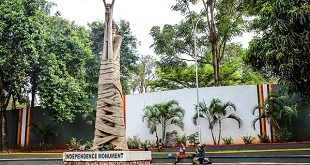
By Joan Akello
Following the expiry of the first five year phased National Trade Sector Development plan last year, the Ministry of Trade, Industry and Cooperatives (MTIC) is developing a new one.
The ministry has hired consultants to engage different stakeholders to input into the next five year NTSDP- 2015/16-2020/21.
One such meeting was held by SEATINI with the main objective of mainstreaming climate change, food security to make the NTSDP more coherent with these emerging national and global challenges.
“Since agriculture, fisheries and forestry compose Uganda’s main activities, its economy is highly climate sensitive, if we have a National Trade Sector Development Plan which caters for food security, climate change and trade, perhaps we can have hope,” said Faith Lumonya, at SEATINI’s programme officer.
The NTSDP is the implementing instrument of the National Trade Policy (NTP) which many trade activists say does not address the question of tackling climate change or that of food security directly.
Lumonya adds that consequently, the gaps that exist within the NTP continue to undermine Uganda’s efforts and contribution towards establishing fair trade deals and as well as devising ways to adapt and or mitigate the challenges of climate change for sustainable development.
At the multilateral level for example, Uganda’s participation in the negotiations under the World Trade Organisation (WTO) especially on trade and agriculture, and the United Nations Framework Convention on Climate Change (UNFCCC) despite their interconnectedness is each undertaken independently by the responsible ministries. The country negotiators within in the WTO process are different from those engaged in the UNFCCC process regardless of the fact that proposals and agreements made within the various negotiations could have far reaching implications on the country’s climate; food security and agriculture production; and trade performance.
Therefore, the concerned stakeholders are meeting the consultant, Alex Nakajjo who has been contracted to formulate NTSDPII on behalf of MTIC.
Nakajjo says he is cognizant of the different interests and therefore will hold several consultative meetings to ensure that the plan is inclusive but most importantly, help improve Uganda’s trade balance and fit within the NTP’s mandate.
Between 2009 and 2013, merchandise exports increased by 21.6 percent from US $2,326 million to US $2,828.7 million while merchandise imports increased at a faster rate of 37percent from US $4,247million to $5,817 million. This therefore accounted for the 55.6 percentage merchandise trade deficit increase from $(1,920.8) in 2009 to $(2,988.8) in 2013.
Also, services exports recorded a 109.6 percent increase from $990 million to $2,075 million, while Services imports increased at a lower 89.8 percent increase from $1,394 million to $2,646 million in the same period under review. As a result, total services trade deficit increased from $(404m) in 2009 to $(571m) in 2013, which was a 41.3 percentage increase.
Uganda therefore needs to fasten the growth of exports to exceed that of imports, if we are to achieve the Vision target of improving trade balance, Nakajjo told the meeting.
But Stephen Biribonwa, in charge of nutrition and food security at the ministry of agriculture, animal industries and fisheries argues that Uganda “should not trade off the environment and food security” to improve its trade balance but the trade ministry should rather promote food storage facilities such as building of silos and warehouses to help farmers improve on post –harvest handling which he says is a very big challenge.
Nakajjo says agricultural trade enhancement is one of the thematic areas to be considered including proposals for a warehouse receipt system, a commodity trade exchange to tackle quality, quantity, and post harvest handling to achieve the NTSDP11’s main goal of increasing trade.
In addition, he says Uganda’s trade balance can be achieved through diversification of export commodities to existing and new markets or intensification of current export commodities to existing and or new markets or both diversification and intensification and recommending a mix of strategies to be implemented under the NTSDPII.
For the last six years, Uganda’s exports were mainly to preferential markets that is East African Community (EAC) and Common Market for Eastern and Southern Africa (COMESA) and the European Union (with 27 member countries).
Though Uganda’s top four export countries are also her neighbours, led by Sudan (17.2 percent), Kenya (13 percent), DRC (11.1 percent) and Rwanda (9 percent), and those destined to the EU recorded modest growth in the same period. Nakajjo says the country must realize that the regional market is not as mature as the latter and is therefore fragile and susceptible to conflicts which can disrupt trade.
Civil society organisation officials at this particular consultative meeting are thereby urging MTIC to ensure that the NTSDP II is also cognizant of food security and climate change and their impact on trade or trade’s impact on them.
 The Independent Uganda: You get the Truth we Pay the Price
The Independent Uganda: You get the Truth we Pay the Price





